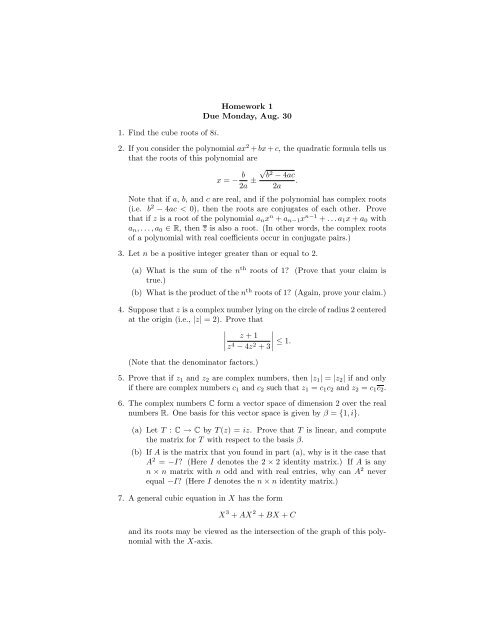Homework 1 Due Monday, Aug. 30 1. Find the cube roots of 8i. 2. If ...
Homework 1 Due Monday, Aug. 30 1. Find the cube roots of 8i. 2. If ...
Homework 1 Due Monday, Aug. 30 1. Find the cube roots of 8i. 2. If ...
You also want an ePaper? Increase the reach of your titles
YUMPU automatically turns print PDFs into web optimized ePapers that Google loves.
<strong>1.</strong> <strong>Find</strong> <strong>the</strong> <strong>cube</strong> <strong>roots</strong> <strong>of</strong> <strong>8i</strong>.<br />
<strong>Homework</strong> 1<br />
<strong>Due</strong> <strong>Monday</strong>, <strong>Aug</strong>. <strong>30</strong><br />
<strong>2.</strong> <strong>If</strong> you consider <strong>the</strong> polynomial ax2 + bx + c, <strong>the</strong> quadratic formula tells us<br />
that <strong>the</strong> <strong>roots</strong> <strong>of</strong> this polynomial are<br />
x = − b<br />
2a ±<br />
√<br />
b2 − 4ac<br />
.<br />
2a<br />
Note that if a, b, and c are real, and if <strong>the</strong> polynomial has complex <strong>roots</strong><br />
(i.e. b 2 − 4ac < 0), <strong>the</strong>n <strong>the</strong> <strong>roots</strong> are conjugates <strong>of</strong> each o<strong>the</strong>r. Prove<br />
that if z is a root <strong>of</strong> <strong>the</strong> polynomial anx n + an−1x n−1 + . . . a1x + a0 with<br />
an, . . . , a0 ∈ R, <strong>the</strong>n z is also a root. (In o<strong>the</strong>r words, <strong>the</strong> complex <strong>roots</strong><br />
<strong>of</strong> a polynomial with real coefficients occur in conjugate pairs.)<br />
3. Let n be a positive integer greater than or equal to <strong>2.</strong><br />
(a) What is <strong>the</strong> sum <strong>of</strong> <strong>the</strong> n th <strong>roots</strong> <strong>of</strong> 1? (Prove that your claim is<br />
true.)<br />
(b) What is <strong>the</strong> product <strong>of</strong> <strong>the</strong> n th <strong>roots</strong> <strong>of</strong> 1? (Again, prove your claim.)<br />
4. Suppose that z is a complex number lying on <strong>the</strong> circle <strong>of</strong> radius 2 centered<br />
at <strong>the</strong> origin (i.e., |z| = 2). Prove that<br />
<br />
<br />
<br />
z + 1<br />
z<br />
4 − 4z2 <br />
<br />
<br />
+ 3<br />
≤ <strong>1.</strong><br />
(Note that <strong>the</strong> denominator factors.)<br />
5. Prove that if z1 and z2 are complex numbers, <strong>the</strong>n |z1| = |z2| if and only<br />
if <strong>the</strong>re are complex numbers c1 and c2 such that z1 = c1c2 and z2 = c1c<strong>2.</strong><br />
6. The complex numbers C form a vector space <strong>of</strong> dimension 2 over <strong>the</strong> real<br />
numbers R. One basis for this vector space is given by β = {1, i}.<br />
(a) Let T : C → C by T (z) = iz. Prove that T is linear, and compute<br />
<strong>the</strong> matrix for T with respect to <strong>the</strong> basis β.<br />
(b) <strong>If</strong> A is <strong>the</strong> matrix that you found in part (a), why is it <strong>the</strong> case that<br />
A 2 = −I? (Here I denotes <strong>the</strong> 2 × 2 identity matrix.) <strong>If</strong> A is any<br />
n × n matrix with n odd and with real entries, why can A 2 never<br />
equal −I? (Here I denotes <strong>the</strong> n × n identity matrix.)<br />
7. A general cubic equation in X has <strong>the</strong> form<br />
X 3 + AX 2 + BX + C<br />
and its <strong>roots</strong> may be viewed as <strong>the</strong> intersection <strong>of</strong> <strong>the</strong> graph <strong>of</strong> this polynomial<br />
with <strong>the</strong> X-axis.
(a) Show that <strong>the</strong> inflection point <strong>of</strong> this graph occurs at X = − A<br />
3 .<br />
(b) Deduce (geometrically) that <strong>the</strong> substitution X = (x− A<br />
3 ) will reduce<br />
<strong>the</strong> above equation to <strong>the</strong> form x3 + bx + c.<br />
(c) Verify part (b) by calculation.<br />
8. In order to find a solution to <strong>the</strong> cubic equation x 3 = 3px + 2q, do <strong>the</strong><br />
following:<br />
(a) Make <strong>the</strong> inspired substitution x = s + t, and deduce that x solves<br />
<strong>the</strong> cubic if st = p and s 3 + t 3 = 2q.<br />
(b) Eliminate t between <strong>the</strong>se two equations, <strong>the</strong>reby obtaining a quadratic<br />
equation in s 3 .<br />
(c) Solve this quadratic to obtain <strong>the</strong> two possible values <strong>of</strong> s 3 . By<br />
symmetry, what are <strong>the</strong> possible values <strong>of</strong> t 3 ?<br />
(d) Given that we know that s3 + t3 = 2q, deduce that<br />
x = 3<br />
<br />
q + q2 − p3 + 3<br />
<br />
q − q2 − p3 .<br />
2
















